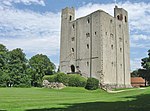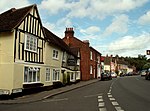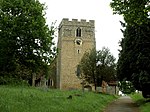Halstead Rural District
Districts of England abolished by the Local Government Act 1972Districts of England created by the Local Government Act 1894Local government in EssexPolitical history of EssexRural districts of England ... and 1 more
Use British English from August 2012
Halstead was a rural district in Essex, England from 1894 to 1974. It was created by the Local Government Act 1894 as a successor to the Halstead rural sanitary district. In 1934 it was greatly enlarged by adding the areas of the disbanded Belchamp Rural District and Bumpstead Rural District. It was abolished under the Local Government Act 1972 and now forms part of the district of Braintree.
Excerpt from the Wikipedia article Halstead Rural District (License: CC BY-SA 3.0, Authors).Halstead Rural District
Rushley Green, Essex
Geographical coordinates (GPS) Address Nearby Places Show on map
Geographical coordinates (GPS)
| Latitude | Longitude |
|---|---|
| N 52 ° | E 0.6 ° |
Address
Rushley Green
Rushley Green
CO9 3AH Essex, Castle Hedingham
England, United Kingdom
Open on Google Maps








